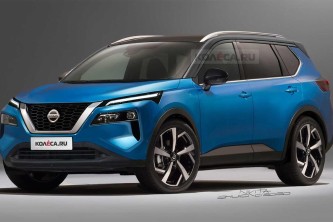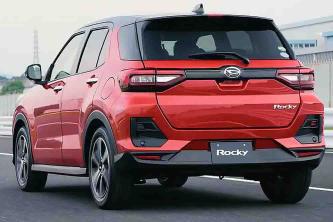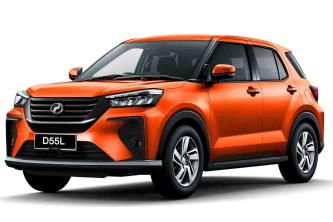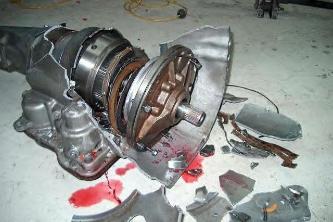transmission xtronic cvt
Artikel Terkait transmission xtronic cvt

Pros and Cons: Proton Iriz – Excellent ride and handling, but the CVT is a pain
the seats offer decent amount of support and comfort for the driver and passengers.Cons – That CVT
Leaked: 2021 Proton Persona facelift (MC2) specs - Still CVT, at least 4 airbags, larger infotainment screen
some of the main changes that the upcoming 2021 Proton Persona facelift (MC2) will get.No more manual, CVT
No 8AT, 2021 Nissan X-Trail to come with CVT with 8 virtual ratios
However, we know that this is not true as more evidence points to the transmission being a CVT with 8
The Nissan Almera Turbo can do 650 km in one full tank, better than regular Honda City i-VTEC?
1.5-litre DOHC naturally aspirated engine, which is the main aim of the Nissan Almera Turbo.Updated transmission
No turbo for 2021 Toyota Harrier Malaysia, leaked leaflet reveals 2.0L NA, CVT, TSS
Dynamic Force 2.0-litre naturally aspirated 4 pot (173 PS, 203 Nm) which is paired to a Direct Shift CVT
New 2021 Proton Iriz will drop its lousy CVT, but can it overtake the Perodua Myvi?
Punch-sourced CVTs could be better.Apart from new looks, its possible that the new Iriz will get a new transmission
DCT vs torque converter, which is your preferred transmission?
the early 90s, if you wanted to buy a performance car, you’d most probably choose the manual transmission
Wait, no 4AT? 2021 Proton Iriz and Proton Persona MC2 might retain Punch CVT
to both models, the MC2 (Minor Change 2).According to our friends at Funtasticko, the Punch-sourced CVT
Review: 2020 Lexus UX 200 2.0L CVT, compact SUV with BMW handling, Lexus refinement
that it checks all the right boxes as the best premium city car.Lexus UX 200 Engine Performance: 2.0L+CVT
Here's why the manual transmission still matters
I would like to stay in the now and appreciate the manual transmission, while it is still with us.I want
Lexus UX’s Direct-Shift CVT is a CVT enthusiasts can accept
First, we need to understand the concept of CVT.
Bangkok 2019: All-new Nissan Almera with 1.0L turbo engine?
consumption and lower CO2 emissions, the all-new Almera will ditch the 4-speed automatic, replaced by an XTronic
Is it true that cars with CVT are less reliable?
overheating CVTs and snapped CVT belts.
4AT vs CVT: Two steps forward, one step back?
Using a never-before-seen transmission in Proton would mean more unique parts, which would lead to higher
All-new 2020 Nissan Almera fuel consumption, over 800 km range per full tank?
Almera is now equipped with an advanced HRA0 1.0-litre 3-cylinder turbocharged petrol engine and an Xtronic
Star MPV Nissan Serena 2.0 s-hybrid MPV Review
About driving, the new Serena powers the front wheels with the new XTRONIC CVT, a big improvement over
Missed opportunity: Where's the manual transmission 2020 Toyota Vios GR Sport?
Which is why were making this case: the Vios GR-S, for all intents and purposes, needs a manual transmission
Nissan recalls 4,001 Nissan Serena S-Hybrid (CBU) – Faulty CVT Control Unit
Nissan Serena S-Hybrid (C26) Completely Built-Up (CBU) variant to reprogram its Continuously Variable Transmission
CVTs - not all are good, not all are bad. Find out who makes the best CVT.
Whether you like it or not, continuously variable transmissions (CVT) are here to stay, as these transmissions
Review: 2019 Proton Iriz 1.6 Premium CVT, for the love of driving
(CVT) in their models like the Emgrand GL?
Review Post transmission xtronic cvt
Drive home the street smart sensation 2018 Nissan Micra that comes with an Xtronic CVT Automatic Transmission for the smoothest of driving experience. So what are you waiting for? #BeStreetSmart and book the Micra today! https://t.co/TGSYkFSahQ https://t.co/rngO6FrD97
MAKANAKI CARS NISSAN MAXIMA 10 3.5L V-6 Engine Xtronic 2-spd CVT w/OD Transmission 290 @ 6,400 rpm HP 261 @ 4,400 rpm Torque FW Drive type ABS & driveline TCS 1st row https://t.co/7vrzdojPAz open/close sliding and tilting glass Sunroof 18" silver aluminum Wheels Front AC, RKE. https://t.co/lnfwEXQSSp
Nissan Altima (2016) https://t.co/Aa6A332l5c #Nissan ONE OWNER!, Private Seller 2016 Nissan Altima 2. 5SL 4 Door, CVT w/Xtronic Transmission - REAR VIEW BACK-UP CAMERA!, BLUETOOTH HANDS-FREE CALLING!, https://t.co/0yBPVgwvMB
Stock #606407,3.5L V6,CVT with Xtronic,88763 mi,20/26 MPG Our Price: $12491 Overview Model: Pathfinder Trim: SL Body: 4D Sport Utility Exterior: Brilliant Silver Interior: charcoal Stock#:606407 VIN #: 5N1AR2MN7DC606407 Mileage: 88763 Engine: 3.5L V6 Transmission: CVT with..... https://t.co/mUPfcfP3Wd
You’ll take every curve like you mean it with responsive steering and nimble handling. And you’ll go even farther with #Kicks’ modern engine, Xtronic #CVT (Continuously Variable Transmission). #NissanNigeria #Nissan #NissanKicks #NissanVehicles #cars https://t.co/GSzWmMjekX
2014 NISSAN NOTE - AERO STYLE PKG - Delivered ✅ ☑1200cc DIG-S supercharged engine ☑Xtronic CVT transmission ☑Eco mode Talk to us today for your next car. Our standards remain the same; High grade, genuine mileage & accident free cars. #envogueautoline #envoguedelivers https://t.co/1meCUxoWti
Whether it’s the 5-speed manual or Xtronic CVT® (Continuously Variable Transmission), power delivery is right there when you need it with the Nissan #Versa. #MJNissan #Team23 https://t.co/6c2yRHAqS7
With Nissan Pathfinder's Xtronic CVT transmission, you have a virtually gearless road warrior. It can hold the engine at the ideal rpm for the job, providing a wave of power when you need it and running low rpm for quiet, efficient cruising when you don't. #Nissan #Pathfinder https://t.co/cbdEuTvB7h
With a 1.8-liter engine and a virtually gearless Xtronic CVT® transmission, the #Sentra was practically designed to get you through Monday. https://t.co/h6yctPfce9
Experience nirvana with the #Nissan Micra’s Xtronic CVT Transmission. Know more at -https://t.co/8qGSNrXliN https://t.co/CJ40oywBJ9
Review Q&A transmission xtronic cvt
Are you a fan of CVT transmissions? Do you have one?
My first encounter with cars using CVT transmission is my mother's 2004 Honda jazz (fit) GD38 (i-dsi 1.5 litre). Granted, the engine produced their peak torque at low rpm range, so it kind of match perfectly with the CVT transmission characteristics. The car was superb in stop & go traffic, and accelerates very well from 0 to about 50 kph-ish. I think that's what a good city car should do. The Honda has a simulated “gear” positions that we can manipulate using +/- buttons on the steering wheel, but it doesn't do much since the engine simply ran out of breath beyond 3,500 rpm. But you know, it is there if you feel like “merging" on American highway without clogging the traffic behind you. This car feel like it has been properly designed by someone who knows about cars. Fast forward, we got a 2013 Nissan Livina with the new HR15DE engine, mated to Nissan's Xtronic CVT. This transmission is simply bad. It feels like 1980s slush box automatic transmission with water instead of automatic transmission fluid spinning the torque converter's impeller. The engine revs, but you can hardly feel the torque. From stop, there is quite a delay when you push the throttle pedal, the engine revs, but the transmission just doesn't lock in. There is some noise, but no oomph, everytime. Indonesian Toyota cars are usually equipped with ancient 4-speed slush box from 1950s like the previous generation Toyota Innova and Avanza. Yet, they feel smoother than this supposedly smoother-by-nature CVT transmission. Combined with the car's awful brake pedal feel (like stomping on a squishy brake button), this car is a massive letdown in city stop-and-go traffic. But on highway, the Nissan's smooth HR engines are sort of okay-ish, as they seemed to be optimised more for inter-city highway cruise. Testament to China's all-manufacturing and no-design approach to product creation. On another occassion, I drove the Subaru XV (Crosstrek) for a test. It was okay, and pretty much unmemorable, which is typical Subaru, as you buy them for the hipster badge, not the actual car. The “chain belt” CVT probably will help holding up the torque coming from the ho-hum weakest-in-competition 2 litre engine and the 4 wheel drive system. But, it still feels distinctively CVT: there is glaring disconnect between the throttle pedal, the engine noise, and actual torque feel. So, if you are CVT drivers, better train your feet in order not to waste too much petrol doing nothing. All in all, I am pretty much neutral, with tendency towards hating the CVT. The one in our previous Honda jazz was superb. But the newer ones installed in our Nissan and the Subaru I test drove are simply awful. Compared to other transmission, CVT might feel smoother, but it does produce some minor jerks, like when it finally matches the engine revs, the Nissan will produce apparent jerk motion before properly accelerating away. The Subaru does this too, under moderate throttle input. An automatic car with 7 or 8 gears will produce the same effect, as the computer that controls their gear changes are getting smarter. The 2012 Hyundai ix35 (Tucson) that my brother owns has one of the smoothest 6 speed automatic gearbox I have ever felt, there isn't much difference between them and the Nissan Livina's Xtronic CVT. As for the future? Well, I am rooting for brushless electric motor drive. It is the smoothest power transmission ever in a car. The only weird thing is that there is no coasting here, so when you let go of the throttle pedal, it will mildly brake the car, there is no feeling of momentum rolling the car, just like your remote control buggy or your electric toy car. The feel is much more direct, as the motor is directly linked to the wheel. This the future for me.
What are the benefits of 2021 Altima's Xtronic CVT?
Well we will start with CVT. CVT is a type of automatic transmission and it is better known for this fuel efficiency and Smoother driving experience…. Now new technology has been found which is XTRONIC CVT which is far better than normal CVT Vehicle Advantages of XTRONIC CVT Fuel efficiency Fun to drive Smooth and quiet at cruising speed
What is better, the 2020 Nissan Murano or the 2020 Hyundai Santa Fe?
The Hyundai Santa Fe by a country mile it has a better built quality than the Nissan Murano and it Sante fe has a much better transmission than the Xtronic CVT that the Nissan have.
Which transmission is better for cars AMT oR CVT?
I don’t know if you can totally blame the CVT, or the particular manufacturer. But Nissan has had issues with these- Nissan Sentra Xtronic CVT Lawsuit Targets 2012-2017 Models
How long does it take for an automaker to fix all teething problems, such as electrical or engine problems, when introducing a new car model or a major model upgrade?
Ohhhh boy. Don’t get me started. How long depends on which automaker we’re talking about, what caused the problem(s) that need to be fixed, and whether or not it is deemed too much trouble or expense to fix anything…or just wait ‘till the next production cycle comes around. A few examples: —————————— The PT Cruiser. I’ve written about the PT before. The PT and my Chev HHR share some DNA as they were both designed by the same guy: Bryan Nesbitt. (Formerly of Chrysler, moved to GM in 2005). The idea came out of a concept car called the Pronto Cruiser that was proposed as a stablemate for Chrysler’s oh-so-sexy (but somewhat impractical) Plymouth Prowler roadster. So they designed a ,sexy beast, of a body…and then decided to use ,MODIFIED(!!!) ,Dodge Neon running gear to bolt that body onto. And hilarity ensued. GM went the opposite way with the HHR. They modded the ,body, to fit the Chevy Cobalt platform. Which led to other problems. ,Verdict: never fixed. —————————— VW TDI. Oh my. The TDI Jettas had it ,all. ,Fuel efficient, fun to drive, roomy, well-built (for a change), and ,clean! At least, that was what the ad copy said. Then, as you may have heard, someone wondered ,why, the car’s emission numbers were so very different when it was on a dyno…as opposed to when it was out on the street. “And we would have gotten away with it…if it hadn’t been for you meddling kids!” Actually, what tripped VW up was the development of ,portable, emissions testing gear that could be installed on a vehicle to monitor emissions during real-world driving conditions. That; and an enviro-nonprofit that was willing to ,use, it. And VW…,balked. ,Verdict: dragging their heels; kicking and screaming. Took much longer than it ought. Seriously; this took WAY too long: With thanks to YouTube user “jacuzzibusguy”. —————————— Nissan “D” platform…and the CVT transmission. Sometime around the turn of the Millenium, Nissan entered into one of those “Global Partnerships” … with Renault. About five years into the partnership, both companies enacted a major production cost savings program by virtue of producing a good portion of ,both ,automaker’s lineup on the same platform. The Nissan “D” platform. Most vehicles were FF layout (front wheel drive, front engine), with a few select models offered with the option for all-wheel drive. They were equipped with a CVT transmission. From the YouTube channel of “AutoMotoTV”. It’s a promo…but already I’m seeing some problems here. That shows the whizzbang NEW XTronic CVT introduced in 2013. When introduced; models equipped with this transmission had a five year drivetrain warranty. Now, five years later, and Nissan/Renault is actually looking to ,offer another five years warranty coverage, on some models. The primary benefit of the CVT transmission is that they’re ,cheap., That is, inexpensive to produce, and with that a corresponding boost to both Automaker’s bottom lines. But…they don’t work very well. Or didn’t. I haven’t read anything lately that would change that opinion; but hope springs eternal. I previously speculated that at this point, Nissan and Renault have so much invested in the CVT drivetrains that it would be unthinkable to re-design the “D” platform — now succeeded by the “Renault - Nissan Common Module Family” — with a better transmission. They seem to be determined to keep flogging these turkeys until such time as they get the bugs worked out…or it becomes too expensive to ,not, fix the problem! Verdict: Sitting on the fence waiting for the latest cost-analysis.
Just how bad is a CVT transmission? Is it worse than a 4-speed automatic transmission?
My mom had a 2004 Honda jazz i-dsi with CVT. It is a very smooth accelerating city cruiser. With a small but efficient 1.5 litre Honda L15A2 engine, producing 86 hp at 4.500 rpm and 131 Nm torque output peak at 2.700 rpm, it is a perfect combination with CVT. From 0 to 40 kph at feather light touch to the gas pedal, the car will accelerate quickly. So it is a very fuel sipping setup from already fuel efficient car. The onpy drawback is that this car is quite polluting. My sister’s current 2014 Nissan Livina is equipped with Nissan’s notoriously troublesome Xtronic CVT. It is however, very smooth too. Combined with newer Nissan’s HR15DE engine, it sips fuel carefully. However, unlike Honda’s low torque setup, the Nissan’s needs a bit of push from the start, which the CVT will respond by holding them in high underdrive ratio until the car starts rolling and then slowly reducing the drive ratio. Meanwhile, my experience with a 4-speed automatic transmission mainly comes from my friend’s 2009 Toyota Avanza, my boss’ 2011 Toyota Innova diesel, and my father’s previous 1989 Honda Accord. To some extent, I also remembered my uncle’s Volvo 960GLE. Those cars are old fashioned and the transmission are jittery at best. Gear changes took about a second, so when your car is climbing on full load, you will feel the jerk. The Toyota Avanza and Innova is a bit newer, so it is much smoother. Yet, it still takes quite a long time for the transmission to adequately couple the power the wheels. Most of the time, I just press the pedal waiting for something to happen. Which usually occurs a few moments later. CVT is good, especially for small city cars, hybrid cars, or other cars with relatively small power and torque output, bigger engines will likely cause CVT some reliability problems. They are never designed with 0 to 100 kph record breaking to mind. It is just a smooth sailing from 0 to 50 kph. So on most red lights stop and go, you’ll launch relatively faster than those cars with 4-speed automatic slushboxes. But, when on highway speed, passing semi trailers, buses, or slower cars will be much easier with the 4-speed automatic, because the modern ones will usually be equipped with lock up clutch that mechanically connects the engine cranskhaft to the driveshaft that turns the wheels via differential. So, power transfer is much more direct. The CVTs will need more time to push the car from 100 kph to 120 kph. Modern automatic with more than 4 gears are usually much better than CVTs, especially at highway cruise. It will also beat CVT in acceleration terms if both cars are pushed to the limits. CVTs in my opinion, are better suited to city driving with frequent stop and go traffic. At high cruising speed, the automatic will more likely win in terms of efficiency too.
CVT transmissions have much faster acceleration and better fuel economy than normal ones, but why aren't they so popular?
First, let’s clarify the statements in your question: CVT transmission does not provide faster acceleration. This is common misconception by unfamiliar audiences. My father used to consider my Mom’s 2004 Honda jazz i-dsi with CVT to be “Formula 1-like” in acceleration. My friend’s husband also claims the same with his wife’s similar car (coincidentally with the same colour as well). His claim was “I tried the new (2008) jazz, it blows, the old one has more power!” First thing first, the Honda jazz or fit with that particular engine is tuned to give maximum torque at lower rpm band, starting around 2.500 rpm. So with little tap on the gas pedal, the car will smoothly accelerate to city cruising speed of 40 kph to 60 kph. This is the usual setup in many “zippy” fuel efficient cars today. Its fuel efficient oriented L15A2 86 hp engine means that beyond the city cruising speed, the car will struggle a little compared to the newer 2008 model ones, which exclusively powered by the 118 hp (L15A7) i-VTEC unit in Indonesia. To properly test cars for acceleration, always floor the pedal. People like my father and my friend’s husband often use their typical everyday traffic light start-stop city driving grocery-getter driving style as reference. By that standard, the massively turbo-boosted 300 hp Mitsubishi Lancer Evolution cars will feel laggy and “blows” like my friend’s husband said, despite producing more than three times of the Honda jazz i-dsi’s power. Regular gas guzzler like the V8 415 hp Lexus IS-F, which kicked out about 500 Nm at 5.200 will feel noticably “heavy” in their economical driving mode. Clearly, the CVT transmission has little to do with that smooth acceleration quality other than being smooth. So it left us with this: Why CVT is not popular despite improving the car’s fuel economy compared to other transmission? There are many CVTs, but we will be discussing the ones commonly used in cars, which is the typical pulley and belt type and the toroidal). Starting with the inherent weakness of the CVT itself: It is arguably less durable. CVTs are belt driven. Continuous use will strain the metal-laced belt. It wears and tears relatively quicker than other more traditional transmissions with more solid components. The newer ones use chain belts, with interlaced metal inserts. It can handle bigger engines without too much wear and tear. It is unreliable. Intended for automatic scooter or motorised carts, installing typical CVT in more powerful, heavier, and faster vehicles with varying driving conditions will pose many unforeseen challenges to the transmission. However it is cheap and relatively simple to make so, it is more than made up for the drawback. The CVTs used in slow speed vehicles like farming implements (e.g. combine harvester) are mechanically different type. Not fun. According to Wikipedia’s sources, the best CVTs can only transmit 88% of the engine’s power. In other transmission, we say lockup ratio. Using the latest technology, typical modern automatic gearbox can have 87% lockup ratio, which is good enough, provided that it is a mechanical connection. CVTs will provide you good push if you just gas it moderately. If you floor it, it will produce almost nothing, you can’t almost feel the car’s true power. Currently, there is a limit on how much the transmission can handle. Put it into big lumbering diesel SUVs that can produce torque of more than 350 Nm, then we will most likely break the chain belt. Americans with their highway commuting culture and self-esteem problems with highway traffic merging means CVT could’t transfer enough “oomph” beyond 80 kph / 50 mph. It will not be as efficient in highway speed as other transmission, negating its main advantage in this situation. CVTs are great for city cars, and their development is quite fast. Nissan currently use the torroidal instead of the more popular belt and pulley thing. I think of several other things beyond the typical CVTs own drawbacks: Interconnected auto manufacturing chains: transmission manufacturer like ZF or Aisin has a lot of non CVT products, surely they would love to sell them. Moreover, their gear suppliers too. This puts a bit of pressure on the adoption of CVT. Many people can’t differentiate between CVT and regular automatic transmission. My Mom still call my sister’s Xtronic CVT equipped Nissan Livina as “matic”. A Honda salesperson in Indonesia autoshow affirms one visitor’s self-reminder “do I need to change the ATF (Automatic Transmission Fluid) in this?” - “yes” said the Honda guy. The car they are talking about is equipped with CVT. This will create indifference between the mass consumers who never cared about all this car thing.
Why does Nissan make such horrible cars?
I don't think they make horrible cars. I think for most part they make pretty good cars. There's only two instances where I can see a Nissan car with a problem. The older Nissan Leafs batteries were air cooled, which is a problem in warmer climates where I live. The Xtronic CVT in various models like the Versa and Sentra have been known to crap out on people fairly early. There's actually a service campaign for my vehicle right now (Versa Note) to reprogram the transmission because I live in a warmer climate.
What is an Xtronic CVT transmission?
You have have answered your own question it a constant variable Transmission built by Jatco in Japan which Nissan motor cooperation own 75% of. Nissan and Renault and Mitibishi have them installed most of all of the Fwd or AWD Vechiles also the RWD vechiles have there CVT to as well.
Is the Nissan CVT reliable?
To be honest, it’s a hit or miss. Nissan has been using the Xtronic transmissions since 06 I believe and the reviews on it are definitely mixed. If you are a person that drives your car softly, then you won’t have any issues whatsoever. However if you drive it like it’s an M3 then yes, the transmission is fragile and can break pretty easily as with all CVTs. I understand the temptation of wanting to buy one of these Nissans used since they cost well below their competition in the used market, however it’s a gamble since you don’t know how the previous owner drove the car. It could either be a bargain or a money pit depending on the car you purchase. And if you want to get one brand new, cars like the 2020 Altima, Sentra, Versa, and 2021 Rogue all have a new generation of the Xtronic CVT and so far there haven’t been any complaints, so it’s already performing better than their predecessors that had issues early on. However time will tell how durable they really are.
 Beranda
Beranda 


